Calorimetry — the fully scalable PAT tool
Pharmaceutical Technology Europe
To date, calorimetry has not been given a fair trial in the PAT arena. Recent advances in reactor technology and design will ensure that real-time calorimetry is the present and future of PAT.
The industry is now at a turning point with the introduction of the PAT initiative by FDA, allowing organizations the freedom to review current operating procedures, and introduce and apply new technology in the pursuit of greater process understanding. The emphasis so far has been on final product testing, but the real benefits will only be realized with the introduction of process monitoring systems early on in the product development life cycle. Providing detailed process knowledge in real-time as early as possible optimizes the process, increases robustness and provides an opportunity for a 'right first time' approach.
There is a vast array of monitoring technologies available. Most have been adapted and modified from existing laboratory techniques and, while providing useful information, are highly susceptible to process changes — making multiple calibrations and complex modelling the standard operating procedure. These techniques are typically more suited to the final production stages where very few changes are likely to occur. Prior to this, the nature of the work involves at least some degree of change or optimization, which makes retuning and inherently recalibration a daily occurrence.

Central to the strategies adopted by most organizations will be to utilize robust and flexible technologies to address the industry's evolving needs. A number of novel or improved analytical techniques have been developed as we seek innovative methods of monitoring the nature and behaviour of drugs, formulations and processes. These often involve a high degree of sophistication not only in relation to the monitoring system and algorithms, but also in terms of the experience and training required to interpret the data. The ideal scenario would include key parameter that could be simply and unambiguously monitored and interpreted. One of the most fundamental parameters that has largely been forgotten is temperature.
Every process produces either an endothermic or exothermic change (or both). It is a direct measurement of change in any process, and its control and monitoring is an area that should and could be exploited to dramatically improve the level of understanding of a process — greatly reducing the time for scale-up.
Calorimetry can address process issues across all areas of an API's life cycle from laboratory development through to the full-scale manufacture. It is only the limitations in the existing technology that has held back its application as a universal monitoring technique.
Reactor design and temperature control
Reactor design. The majority of APIs are developed and manufactured using a constantly stirred batch reactor, which despite numerous step changes still relies on the same approach for controlling the temperature that was developed more than 100 years ago. These systems continue to provide sufficient quantities of all pharmaceutical products required by the market, but the efficiencies and costs of these processes are less than optimum. One fundamental issue inherent in the design of these systems is the inability to provide responsive temperature control (Figure 1). The two illustrations in Figure 2 show the basic configuration applied to both the laboratory- and industrial-sized reactor.
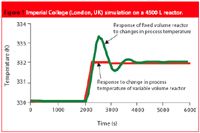
Figure 1
Temperature control. In terms of temperature control, the basic design and concept of a large reactor does not change significantly from the systems used in the laboratory. The process temperature in the systems is controlled by varying both the temperature and flow rate of the heat transfer fluid (HTF) surrounding the vessel.
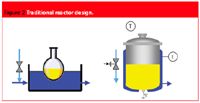
Figure 2
The volume of HTF employed at such a large scale simply makes this level of control impossible, severely compromising the carefully developed method from the laboratory. In addition, the surface to volume ratio of the larger vessels also places the engineer at a severe disadvantage when trying to scale the data generated by a 1 L to 100 L reactor, requiring crude estimates.
These large volumes, often hundreds of litres, present a high level of thermal inertia, making the desired response to temperature changes (planned or otherwise) extremely slow and difficult to maintain. This limits the development team's scope to achieve the ideal/optimum conditions, compromising the quality and consistency of the final product because of the inefficiencies and heat transfer capabilities of this standard jacket configuration. Many methods are developed with the assumption that large tolerances — in terms of the desired temperature — have to be built into the method, and an acceptance that there will inevitably be variances in product quality and yield from run to run, and batch to batch.
Calorimetry offers the opportunity to provide the quality of information required to bridge the gap that exists when moving from the laboratory, and allow more informed decisions to be made as the process progresses though to full-scale production.
Why hasn't calorimetry been used before?
This need to constantly cycle the HTF to achieve the set temperature creates huge enthalpy shifts masking any signal generated by the process itself.
Improving the control would allow the workhorse of the pharmaceutical industry to be transformed into an on-line, nonintrusive monitoring system.
Calorimetry methods
Although offering one of the most fundamental and potentially useful forms of data, it has rarely been used because conventional calorimetric techniques tend to be very difficult to use at anything beyond the laboratory scale. The current approaches to calorimetry are heat-flow, heat-balance and power compensation. For a standard jacketed vessel these are two ways of estimating the heat released during the reaction (Figure 3).
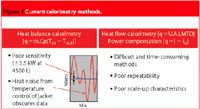
Figure 3
- Enthalpy change of cooling medium: QA = FCp(Tin – Tout)
- Heat transfer rate: QB = UA(Tj – Tr)
Heat flow can be sensitive, but not practical beyond the laboratory scale. It is adversely affected by any change in the process conditions such as agitator speeds and viscosity; these affect the heat coefficient value, which has to be predetermined before the process begins and results in numerous calibrations being performed. Practically, heat balance calorimetry offers the most robust solution, particularly for the larger volumes. As mentioned earlier, the graph shows a typical profile for the changing enthalpy experienced during a process as the temperature control unit struggles to respond to the changes in the process temperature. The only possibility for monitoring is to turn off or lock the control, but this is not practical for everyday use.
Improvements in the temperature control and calorimetry data would lead to significant benefits and support the primary goals of PAT with the establishment of reproducible methods and a guarantee of product quality.
What will calorimetry reveal about a process?
Calorimetry can be used to monitor or control all chemical, physical and biological processes providing data on the enthalpy, power and the heat coefficient. This gives a direct indication of the activity and changes of any process, allowing a number of key variables to be monitored — a central tenet of PAT.
Calorimetry already provides excellent information for the safety aspects of a process, but if extended beyond this niche application could offer accurate on-line monitoring of all processes to compare with any existing technique.
This aspect is critical when considering how to monitor processes. Heat is a universal parameter and all reactions experience thermal changes — making it the starting point for any process development — and its potential application limitless. It also compares well to other techniques, which, although capable of producing good quality data specific to the process, are often limited to one process and are also susceptible to any changes in the conditions of the process.
There are very few methods that provide nonintrusive on-line monitoring techniques. The raw data provided needs to dynamically reflect changes as they happen and not be adversely affected by changes in a process. Typically, a series of calibrations is required to try and anticipate any changes to the method.
It is also an on-line, nonintrusive technique for monitoring and optimizing a process, which, as a PAT tool, offers many possibilities to improve areas such as:
- End point detection. Precise determination using enthalpy of the end-point rather than relying upon time based estimates. Ensure optimum yield achieved and prevent process from being terminated too early.
- Constant accumulation addition. Prevent thermal runaways, improve control and repeatability of highly exothermic reactions (e.g., Grignard reactions).
- Crystallization control (constant C/Csat). Accurate control of cooling profiles/rates.
- Real-time measurement of heat transfer coefficient (U). Diagnostics for agitation efficiency, fouling, ice formation or boiling at the heat transfer surface. Monitoring viscosity.
- Monitor and control of bioreactors. Monitor enthalpy to track bioactivity and control of addition of feeds.
- Determine precise process specific thermal profiles or signatures. Establish thermal fingerprint for each process to ensure repeatability.
- Scalability. Opportunity to apply identical method of monitoring and control across all stages of development and scale-up.
Future developments
Recent advances in a technology called coflux (Figure 4) have allowed the development of a new form of reactor, which will enable accurate calorimetry across all sizes of reactor. The fundamental difference of this technology being the use of a variable area heating jacket. This effectively provides a series of coils or jackets, which can be controlled independently.
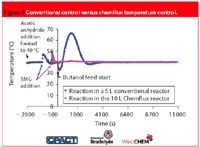
Figure 4
Using area as the control parameter (instead of temperature and flow) immediately improves the S/N ratio for all processes. This allows very sensitive measurements to be obtained as the enthalpy shifts caused by constantly changing the temperature and flow of the HTF is virtually eliminated. This removes the thermal inertia created by the large volume jacket, and greatly improves the level of control and response, allowing the calorimetric information to be usefully employed in all aspects of process design and scale-up.
Research at the Centre for Process Analytics and Control Technology (CPACT) at Strathclyde University (UK) using this technology at the 10 L-scale has shown how responsive temperature control and accurate calorimetry can provide comparable data to both gas chromatography and near infrared data (Figure 5).
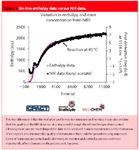
Figure 5
Summary
Heat measurements represent the purest form of change available and can, with recent developments, become a key enabling technology to introduce significant changes to the way a company operates its processes and business overall.
Previously, the obstacle has been a fundamental inability to instigate a high level of control at the same time (Figure 6) as providing an accurate method of monitoring, effectively removing calorimetry from the arsenal of analytical techniques used by scientists and engineers at anything beyond the laboratory scale.
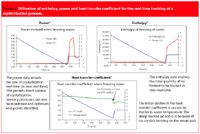
Figure 6
It is only now that the significant advancements in reactor technology, combined with the opportunity that PAT has provided, will allow calorimetry to address the needs of process development and scale-up in the pharmaceutical and bioprocessing industries.
Kathryn Hipkins is product manager for PSL ChemFlux at Powder Systems (UK), leading the development of innovative products such as ChemFlux reactors. Kathryn spent 14 years working for Baxter HealthCare, formerly ML Laboratories, as development manager with responsibility for process optimization, scale-up and validation. She is a chemistry graduate and member of the Royal Society of Chemistry.
Drug Solutions Podcast: A Closer Look at mRNA in Oncology and Vaccines
April 30th 2024In this episode fo the Drug Solutions Podcast, etherna’s vice-president of Technology and Innovation, Stefaan De Koker, discusses the merits and challenges of using mRNA as the foundation for therapeutics in oncology as well as for vaccines.